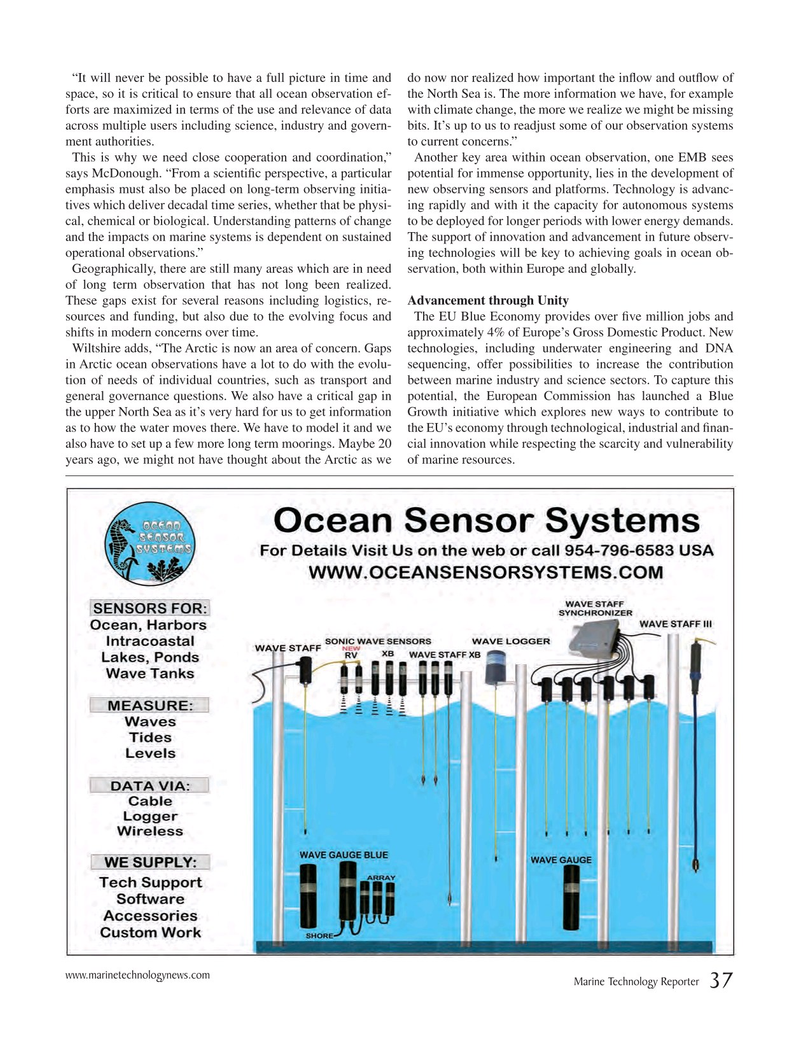
Page 37: of Marine Technology Magazine (September 2016)
Ocean Observation: Gliders, Buoys & Sub-Surface Networks
Read this page in Pdf, Flash or Html5 edition of September 2016 Marine Technology Magazine
“It will never be possible to have a full picture in time and do now nor realized how important the in? ow and out? ow of space, so it is critical to ensure that all ocean observation ef- the North Sea is. The more information we have, for example forts are maximized in terms of the use and relevance of data with climate change, the more we realize we might be missing across multiple users including science, industry and govern- bits. It’s up to us to readjust some of our observation systems ment authorities. to current concerns.”
This is why we need close cooperation and coordination,” Another key area within ocean observation, one EMB sees says McDonough. “From a scienti? c perspective, a particular potential for immense opportunity, lies in the development of emphasis must also be placed on long-term observing initia- new observing sensors and platforms. Technology is advanc- tives which deliver decadal time series, whether that be physi- ing rapidly and with it the capacity for autonomous systems cal, chemical or biological. Understanding patterns of change to be deployed for longer periods with lower energy demands. and the impacts on marine systems is dependent on sustained The support of innovation and advancement in future observ- operational observations.” ing technologies will be key to achieving goals in ocean ob-
Geographically, there are still many areas which are in need servation, both within Europe and globally.
of long term observation that has not long been realized.
These gaps exist for several reasons including logistics, re- Advancement through Unity sources and funding, but also due to the evolving focus and The EU Blue Economy provides over ? ve million jobs and shifts in modern concerns over time. approximately 4% of Europe’s Gross Domestic Product. New
Wiltshire adds, “The Arctic is now an area of concern. Gaps technologies, including underwater engineering and DNA in Arctic ocean observations have a lot to do with the evolu- sequencing, offer possibilities to increase the contribution tion of needs of individual countries, such as transport and between marine industry and science sectors. To capture this general governance questions. We also have a critical gap in potential, the European Commission has launched a Blue the upper North Sea as it’s very hard for us to get information Growth initiative which explores new ways to contribute to as to how the water moves there. We have to model it and we the EU’s economy through technological, industrial and ? nan- also have to set up a few more long term moorings. Maybe 20 cial innovation while respecting the scarcity and vulnerability years ago, we might not have thought about the Arctic as we of marine resources. www.marinetechnologynews.com
Marine Technology Reporter 37
MTR #7 (34-49).indd 37 8/24/2016 1:35:21 PM

 36
36

 38
38
